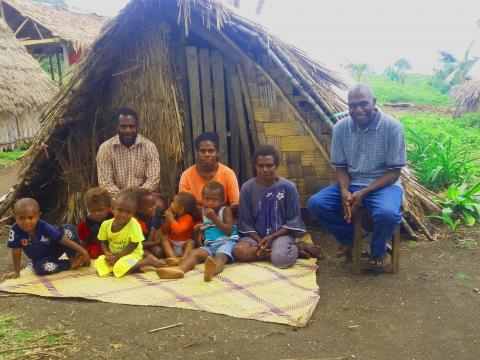Making home safer

Ierwareng village on the south west coast of Tanna in Vanuatu is highly susceptible to disasters. The village, which has a population of about 60 people, is sandwiched between tall mountains and a rocky coastal seafront.
On a regular day, the wind in the village would easily blow the cap off anyone’s head while storms and cyclones can be terrifying and dangerous for villagers as there is very little protection from the wind. The threat of being inundated by sea water during storms is a very real one.
Tsunamis also pose a threat to residents. Reaching higher ground is a challenge for the whole community, particularly children, those with disabilities and the elderly. The safest place for community members in the event of a tsunami is a more than two hundred metre climb up the steep side of a mountain.
Another challenge they face is the salt spray. As the waves crash into the rocky coastline, the gusts of wind spray the sea salt straight into the village, sometimes killing crops and damaging property.
Floods are another potential hazard in the community. It rains a lot in the nearby mountains. The runoff pours down the slopes to the village, sometimes flooding homes.
Things started to change a year ago when World Vision partnered with the Vanuatu Meteorological and Geo-Hazards Department to raise awareness about the importance of disaster risk reduction in the community.
“We are so grateful because after that training we now understand what is happening around us,” stated father of five, Amos.
He went on to add emotionally, “It wasn’t until then that we realised the danger we were putting our wives and children in and we knew that we had to make a change.”
Amos walked through the village pointing out the changes that had been made in the village since the training, the first of which was a cyclone-resistant house built from local materials. It was a traditional house that had been used by their forefathers to weather powerful storms. The house had reed roofing that went down to the ground on all sides so the wind would slide over the building rather than through or under it. The building was held up by a huge frame and beams that were placed much deeper than usual in the ground. He then mentioned specific points around the house where extra beams would be installed for greater reinforcement. During the training the community learnt that these types of houses were much safer than some of the poorly constructed concrete houses that had previously been built in the community.
As he was pointing at the building, Amos shared, “We built two of these. The small one is for the men and the bigger one is for the women and children to go into when they know a storm is coming. There they will have food, water, medication if available, dry clothes and bedding.”
Amos’ 17-year-old daughter Jocelyn said, “Now these shelters are built, I think my father, grandparents, siblings and I will be safer during storms.”
The other major change in the community is drainage. A ditch, which took about two weeks to dig, runs across one side of the village down to the rocks near the sea to drain water collected in the area.
“This drainage has helped so much because now families no longer wake up in the morning to find clothes, pots and other things floating around inside the house. This has also helped with the road conditions, reducing flooding and making it easier for vehicles to use the road. This is the only access for people further along who are transporting people and goods to and from town. There is no other major road through these hills,” Amos explained.
To deal with the issue of crops affected by salt spray, the villagers have moved their major gardens away from the sea and up to farming land in the hills.
Sophie, aged 53, lives in the same village and shared, “Our people have always depended on crops to survive so we encourage our people to plant healthy crops in the hills and not waste time on making gardens by the sea as their children depend on them.”
Finally, to help reduce the risk posed by tsunamis, safer, more accessible evacuation routes were identified. A safe house was also built to provide shelter for evacuees.
Amos shared, “This is home for us. If we must move away someday because of the risks, we will, but for now we have been given the knowledge to keep our families as safe as possible.”
World Vision’s Agricultural Development for Tanna’s Economic Growth (ADTEG) project, funded by the New Zealand governent and private donations from the New Zealand public, includes a disaster risk reduction component that works with 8,155 people in six communities in the south and south west of Tanna.